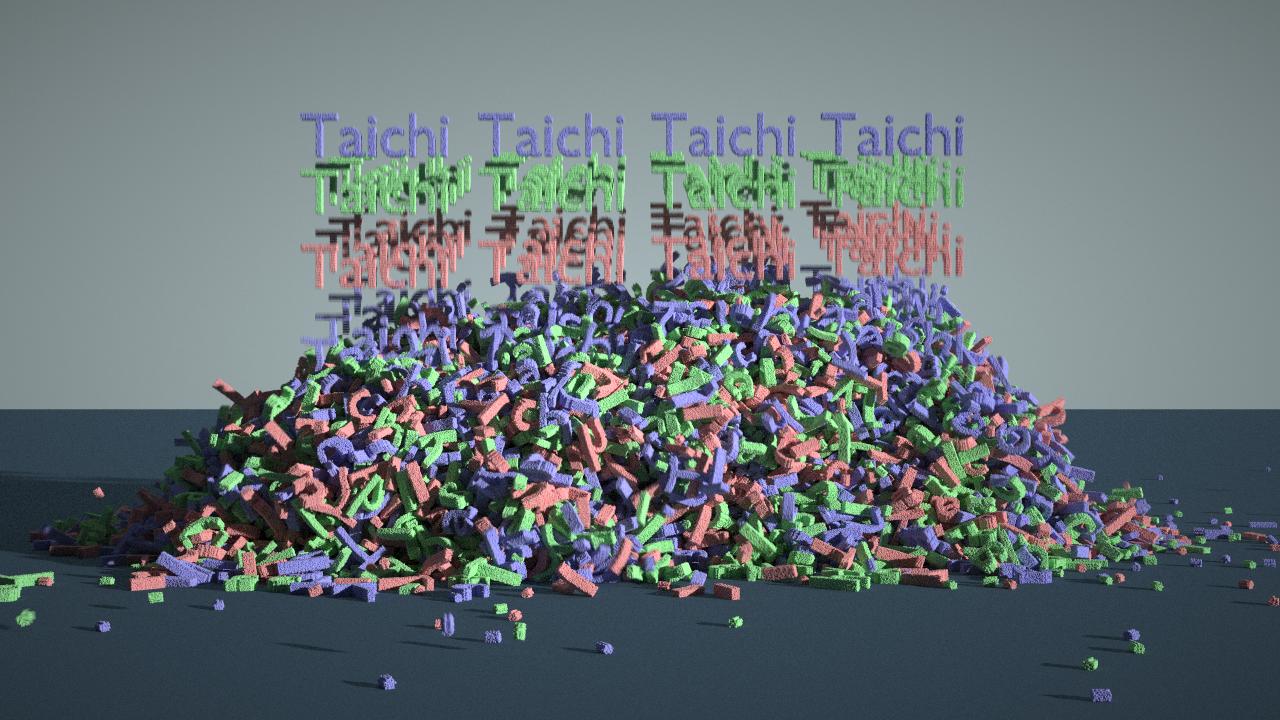taichi-dev / Taichi_elements
Licence: mit
High-performance multi-material continuum physics engine in Taichi
Stars: ✭ 193
Programming Languages
python
139335 projects - #7 most used programming language
Taichi Elements 

High-Performance Multi-Material Continuum Physics Engine (work in progress).
The solver is being developed using Taichi, therefore it is cross-platform and supports multithreaded CPUs and massively parallel GPUs.
The plan is
- To build a reusable MLS-MPM multimaterial (water/elastic/snow/sand/mud) simulator
- To integrate the simulator into Blender
Using taichi_elements in Python
- Install taichi with
pip:python3 -m pip install taichi -
python3 demo/demo_2d.pyand you will see

-
python3 demo_3d.pyand you will see a 3D simulation visualized in 2D.
To simulate and render an example 3D scene with Python
- Make sure you have a modern NVIDIA GPU (e.g. GTX 1080 Ti)
- Download
taichi.plyand runpython3 demo_3d_letters.py(wait for at least 10 frames)- A binary particle folder with a timestamp in its time (e.g.,
sim_2020-07-27_20-55-48) will be created under the current folder.
- A binary particle folder with a timestamp in its time (e.g.,
-
python3 engine/render_particles [particle_input_folder] [begin] [end] [step] [render_output_folder]- E.g.,
python3 engine/render_particles.py sim_2020-07-27_20-55-48/ 0 100 1 frames
- E.g.,
- Images are in the
renderedfolder. For example, 100 million MPM particles simulated in 8 hours on a V100 GPU:
Using taichi_elements in Blender
Installing Taichi for Blender
(Not sure if it is the standard approach, but it works for now.)
- Find the Python3 executable bundled in Blender. Open a console in Blender and type in
import sys
print(sys.exec_prefix)
The output looks like /XXX/blender-2.81a-linux-glibc217-x86_64/2.81, which means python3 is located at /XXX/blender-2.81a-linux-glibc217-x86_64/2.81/python/bin/python3.7
- Install pip using that Python executable
- Install Taichi:
./python3.7m -m pip install --upgrade taichi(Note: as of July 28 2020, Taichi version isv0.6.22. Please use the latest version.)
Installing taichi_elements (experimental) for Blender
- Set the environment variable
BLENDER_USER_ADDON_PATH, e.g./home/XXX/.config/blender/2.81/scripts/addons - Go to
utilsfolder - Execute
python3 install_blender_addon.pyto install the addon- If you are doing development and wish to keep refreshing the installed addon, add argument
-k.
- If you are doing development and wish to keep refreshing the installed addon, add argument
- Restart Blender to reload the addon
Note that the project description data, including the texts, logos, images, and/or trademarks,
for each open source project belongs to its rightful owner.
If you wish to add or remove any projects, please contact us at [email protected].

